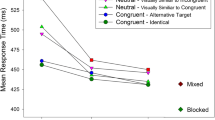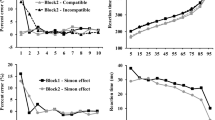Abstract
Even though stimulus location is task irrelevant, reaction times are faster when the location of the stimulus corresponds with the location of the response than when it does not. This phenomenon is called the Simon effect. Most accounts of the Simon effect are based on the assumption that it arises from a conflict between the spatial code of the stimulus and that of the response. In this paper a computational model of this hypothesis is presented. It provides a computationally explicit mechanism of the Simon effect. Consistent with human performance, the model provides reaction times that indicate both an advantage for the ipsilateral, corresponding response (i.e., facilitation) and a disadvantage of the contralateral, noncorresponding response (i.e., inhibition). In addition, the model accounts for the fact that the size for the effect depends on task difficulty.
Similar content being viewed by others
References
Acosta, E., & Simon, J. R. (1976). The effect of irrelevant information on the stages of processing. Journal of Motor Behavior, 8, 181–187.
Beech, A. R., Powell, T. J., McWilliams, J., & Claridge, G. (1989). Evidence of reduced “cognitive inhibition” in schizophrenia. British Journal of Psychology, 28, 110–116.
Benson, D. F., Stuss, D. T., Naeser, M. A.. Weir, W. S., Kaplan, E. F., & Levine, H. (1981). The long-term effects of prefrontal leukotomy. Archives of Neurology, 38, 165–169.
Bundesen, C. (1991). A theory of visual attention. Psychological Review, 97, 523–547.
Cohen, J. D., & Huston, T. A. (1994). Progress in the use of interactive models for understanding attention and performance. In: C. Umiltà and M. Moscovitch (Eds.), Attention and Performance XV (pp. 453–475). Cambridge (MA): MIT Press.
Cohen, J. D., Dunbar, K., & McClelland, J. L. (1990). On the control of automatic processes: A parallel distributed processing account of the Stroop effect. Psychological Review, 97, 332–361.
Comalli, P. E., Wapner, S., & Werner, H. (1962). Interference effects of a Stroop color-word test in children, adulthood, and aging. Journal of Genetic Psychology, 100, 47–53.
Craft, J. L., & Simon, J. R. (1970). Processing symbolic information from a visual display: Interference from an irrelevant directional cue. Journal of Experimental Psychology, 83, 414–420.
De Jong, R., Liang, C. C., & Lauber, E. (1994). Conditional and unconditional automaticity: A dual-process model of effects of spatial stimulus-response correspondence. Journal of Experimental Psychology: Human Perception and Performance, 20, 731–750.
Hasbroucq, T., & Guiard, Y. (1991). Stimulus-response compatibility and the Simon effect: Toward a conceptual clarification. Journal of Experimental Psychology: Human Perception and Performance, 17, 246–266.
Hedge, A., & Marsh, N. W. A. (1975). The effect of irrelevant spatial correspondences on two-choice response time. Acta Psychologica, 39, 427–439.
Hommel, B. (1993a). The relationship between stimulus processing and response selection in the Simon task: Evidence for a temporal overlap. Psychological Research, 55, 280–290.
Hommel, B. (1993b). Inverting the Simon effect by intention. Psychological Research, 55, 270–279.
Hommel, B. (1994). Effects of irrelevant spatial S-R compatibility depend on stimulus complexity. Psychological Research, 56, 179–184.
Houghton, G., & Tipper, S. P. (1994). A model of inhibitory mechanisms in selective attention. In D. Dagenbach and T. H. Carr (Eds.), Inhibitory processes in attention, memory, and language (pp. 53–112). New York: Academic Press.
Kornblum, S., Hasbroucq, T., & Osman, A. (1990). Dimensional overlap: Cognitive basis for stimulus-response compatibility — A model and a taxonomy. Psychological Review, 97, 253–270.
Lu, C.-H., & Proctor, R. W. (1995). The influence of irrelevant location information on performance: A review of the Simon and spatial Stroop effects. Psych onomic Bulletin & Review, 2, 174–207.
McClelland, J. L. (1992). Toward a theory of information processing in graded, random, interactive networks. In D. Mayer & S. Kornblum (Eds.), Attention & Performance XIV (pp. 655–688). Cambridge (MA): MIT Press.
Nicoletti, R., & Umiltà, C. (1994). Attention shifts produce spatial stimulus codes. Psychological Research, 56, 144–150.
O'Leary, M. J., & Barber, P. J. (1993). Interference effects in the Stroop and Simon paradigms. Journal of Experimental Psychology: Human Perception and Performance, 19, 830–840.
Plaut, D. C., McClelland, J. L., Seidenberg, M. S., & Patterson, K. E. (1994). Understanding normal and impaired word reading: Computational principles in quasi-regular domains. Technical Report PDP.CNS. 94.5, Carnegie Mellon University.
Reeve, T. G., & Proctor, R. W. (1988). Determinants of two-choice reaction-time patterns for same- and different-hand finger pairings. Journal of Motor Behavior, 20, 317–340.
Simon, J. R. (1990). The effect of an irrelevant directional cue on human information processing. In R. W. Proctor and T. G. Reeve (Eds.), Stimulus-response compatibility: An integrated perspective (pp. 31–88). Amsterdam: North-Holland.
Simon, J. R., & Acosta, E. (1982). Effects of irrelevant information on the processing of relevant information: Facilitation and/or interference? The influence of experimental design. Perception & Psychophysics, 31, 383–388.
Simon, J. R., & Craft, J. L. (1970). Effects of an irrelevant auditory stimulus on visual choice reaction time. Journal of Experimental Psychology, 86, 272–274.
Simon, J. R., & Rudell, A. P. (1967). Auditory S-R compatibility: The effect of an irrelevant cue on information processing. Journal of Applied Psychology, 51, 300–304.
Stoffels, E. J., & Van der Molen, M. W. (1988). Effects of visual and auditory noise on visual choice reaction time in a continuous-flow paradigm. Perception & Psychophysics, 44, 7–14.
Stoffels, E. J., Van der Molen, M. W., & Keuss, P. G. J. (1989). An additive factor analysis of the effect(s) of location cues associated with auditory stimuli on stages of information processing. Acta Psychologica, 70, 161–197.
Stoffer, T. H. (1991). Attentional focussing and stimulus-response compatibility. Psychological Research, 53, 127–135.
Strutt, G. F., Anderson, D. R., & Well, A. D. (1975). A developmental study of the effects of irrelevant information on speeded classification. Journal of Experimental Child Psychology, 20, 127–135.
Stuss, D. T., & Benson, D. F. (1984). Neuropsychological studies of the frontal lobes. Psychological Bulletin, 95, 3–28.
Tipper, S. P. (1991). Less attentional selectivity as a result of declining inhibition in older adults. Bulletin of the Psychonomic Society, 29, 45–47.
Tipper, S. P., Borque, T., Anderson, S., & Brehaut, J. (1989). Mechanisms of attention: A developmental study. Journal of Experimental Child Psychology, 48, 353–378.
Tipper, S. P., Weaver, B., & Houghton G. (1994). Behavioural goals determine inhibitory mechanisms of selective attention. Quarterly Journal of Experimental Psychology, 47A, 809–840.
Umiltà, C., & Liotti, M. (1987). Egocentric and relative spatial codes in S-R compatibility. Psychological Research, 49, 81–90.
Umiltà, C., & Nicoletti, R. (1985). Attention and coding effects in S-R compatibility due to irrelevant spatial cues. In M. I. Posner and O. S. M. Marin (Eds.), Attention and performance XI (pp. 457–471). Hillsdale (NJ): Erlbaum.
Umiltà, C., & Nicoletti, R. (1990). Spatial stimulus-response compatibility. In R. W. Proctor & T. G. Reeve (Eds.), Stimulus-response compatibility: An integrated perspective (pp. 89–116). Amsterdam: North-Holland.
Umiltà, C., & Nicoletti, R. (1992). An integrated model of the Simon effect. In J. Alegria, D. Holender, J. Junca de Morals, & M. Radeau, Analytic approaches to human cognition (pp. 331–349). Amsterdam: Elsevier.
Ungerleider, L. G., & Mishkin, M. (1982). Two cortical visual systems. In D. J. Ingle, M. A. Goodale, & R. J. W. Mansfield (Eds.), Analysis of visual behavior (pp. 549–586). Cambridge (MA): MIT Press.
Verfaellie, M., Bowers, D., & Heilman, K. M. (1990). Attentional processes in spatial stimulus-response compatibility. In R. W. Proctor and T. G. Reeve (Eds.), Stimulus-response compatibility: An integrated perspective (pp. 261–275). Amsterdam: North-Holland.
Wallace, R. J. (1971). S-R compatibility and the idea of a response code. Journal of Experimental Psychology, 88, 354–360.
Zachay, A. (1991). Diskrete und kontinuierliche Inform ationverarbeitungsmodelle zur Erklaerung von Reiz-Reaktions-Inkompatibilitaeten: Evidenz fuer einen Antwortkonflikt beim Simon-Effect. Unpublished master's thesis, Tuebingen, Germany.
Zorzi, M., Houghton, G., & Butterworth, B. (1995). Two routes or one in reading aloud? A connectionist dual-process model. Technical Report UCL.RRG.95.1, University College London.
Author information
Authors and Affiliations
Corresponding author
Rights and permissions
About this article
Cite this article
Zorzi, M., Umiltá, C. A computational model of the Simon effect. Psychol. Res 58, 193–205 (1995). https://doi.org/10.1007/BF00419634
Received:
Accepted:
Issue Date:
DOI: https://doi.org/10.1007/BF00419634




